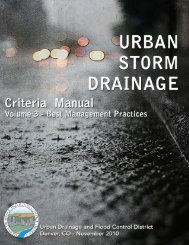Hydraulic Efficiency of Grate and Curb Inlets - Urban Drainage and ...
Hydraulic Efficiency of Grate and Curb Inlets - Urban Drainage and ...
Hydraulic Efficiency of Grate and Curb Inlets - Urban Drainage and ...
You also want an ePaper? Increase the reach of your titles
YUMPU automatically turns print PDFs into web optimized ePapers that Google loves.
5.6 Summary<br />
The current state-<strong>of</strong>-the-art in determining inlet efficiency was illustrated in this chapter<br />
by application <strong>of</strong> methods provided in the USDCM to the Type 13, 16, <strong>and</strong> R inlets. Agreement<br />
with observed test data was generally very poor with efficiency over-predicted by an average <strong>of</strong><br />
20% for the Type 13 <strong>and</strong> 16 inlets <strong>and</strong> under-predicted by an average <strong>of</strong> 7% for the Type R curb<br />
inlet. Methods given in the USDCM were improved by developing splash-over velocity<br />
coefficients specifically for the Type 13 <strong>and</strong> 16 combination inlets. While splash-over velocity<br />
was not specifically sought in the testing, it was determined analytically from the collected test<br />
data for the combination inlets. This was done by utilizing the accepted calculation procedures<br />
given in the USDCM to back-calculate the splash-over velocity for each test. A third-order<br />
polynomial regression was then fitted to the calculated splash-over velocity data to provide<br />
updated coefficients. The splash-over velocity coefficients are reflective <strong>of</strong> the combinationinlet<br />
performance, not the grate-only inlet performance, <strong>and</strong> provide a considerably improved fit<br />
to the observed efficiency data with efficiency errors averaging 10%. USDCM calculation<br />
procedures for the Type R curb inlet were improved by re-developing the regression coefficient<br />
<strong>and</strong> exponents for the original equation. The form <strong>of</strong> the original equation was preserved, <strong>and</strong><br />
the overall fit to the observed efficiency data was improved considerably with efficiency errors<br />
averaging 3.8%.<br />
Development <strong>of</strong> independent empirical equations by dimensional analysis provided an<br />
alternative approach to the currently used UDFCD methods. Physically-meaningful parameters<br />
were combined to produce a single, dimensionally consistent, equation for each inlet. These<br />
equations were found to predict efficiency values that differed by an average <strong>of</strong> 5% from the<br />
observed test data for each <strong>of</strong> the Type 13, 16, <strong>and</strong> R inlets. A comparison, by depth <strong>and</strong> inlet<br />
type, for all methods is presented in Table 5-3. In this table, each method is compared to the<br />
observed test data for maximum <strong>and</strong> average efficiency error. The original UDFCD methods<br />
were most accurate at the lowest test depth <strong>of</strong> 0.333 ft for the Type 13 <strong>and</strong> 16 inlets. For the<br />
Type R inlet they were most accurate at larger depths. Improved UDFCD methods show<br />
significant improvement at larger depths. Empirical equations were most accurate at 0.5- <strong>and</strong> 1-<br />
ft depths. Recommendations for calculation method use are given in the conclusion chapter <strong>of</strong><br />
this report. A tabular, test-by-test efficiency calculation comparison is presented in Appendix H.<br />
74
















